

Aquarium Aquaponics. As I mentioned in another aquaponics post, I am planning to put together my own small aquaponics system for fun, and of course to see if I can get it to work properly.
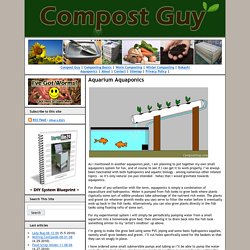
I’ve always been fascinated with both hydroponics and aquatic biology – among numerous other related topics – so it’s only natural (no pun intended – haha) that I would gravitate towards aquaponics. For those of you unfamiliar with the term, aquaponics is simply a combination of aquaculture and hydroponics. Water is pumped from fish tanks to grow beds where plants (typically some sort of edible produce) take advantage of the nutrient rich water. The plants and gravel (or whatever growth media you use) serve to filter the water before it eventually ends up back in the fish tanks. Alternatively, you can also grow plants directly in the fish tanks using floating rafts of some sort.
What is coppicing? Keyhole Gardens. Keyhole Gardens First made popular in Africa, keyhole gardens are catching on in Texas and other hot, dry places.
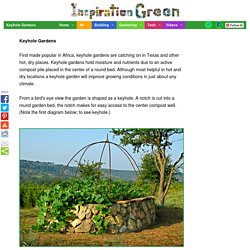
Keyhole gardens hold moisture and nutrients due to an active compost pile placed in the center of a round bed. Although most helpful in hot and dry locations a keyhole garden will improve growing conditions in just about any climate. From a bird's eye view the garden is shaped as a keyhole. A notch is cut into a round garden bed, the notch makes for easy access to the center compost well. Permies: a big crowd of permaculture goofballs. Build a PVC cucumber/vine trellis. 52 Plants In The Wild You Can Eat.
We all know our market vegetables and fruits are safe to eat, but what about other wild edibles?

Here are a few common (North American) goodies that are safe to eat if you find yourself stuck in the wild… first of all, please note that you need to know with certainty the identity of what you are finding and collecting as survival food. If you are not sure – leave it alone. Blackberries: Many wild berries are not safe to eat, it’s best to stay away from them. But wild blackberries are 100% safe to eat and easy to recognize. Dandelions: The easiest to recognize is the dandelion, in the spring they show their bright yellow buds. Asparagus: The vegetable that makes your pee smell funny grows in the wild in most of Europe and parts of North Africa, West Asia, and North America.
Elderberries: Organic farming. Method of agriculture meant to be environmentally friendly World map of organic agriculture (hectares)[1] Organic agricultural methods are internationally regulated and legally enforced by many nations, based in large part on the standards set by the International Federation of Organic Agriculture Movements (IFOAM), an international umbrella organization for organic farming organizations established in 1972.[8] Organic agriculture can be defined as "an integrated farming system that strives for sustainability, the enhancement of soil fertility and biological diversity while, with rare exceptions, prohibiting synthetic pesticides, antibiotics, synthetic fertilizers, genetically modified organisms, and growth hormones".[9][10][11][12] History[edit] Agriculture was practiced for thousands of years without the use of artificial chemicals.
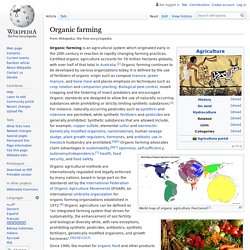
Artificial fertilizers were first created during the mid-19th century. In 1940 Howard published his An Agricultural Testament. Terminology[edit] Methods[edit] Agriculture Library Index. HOME PAGE Sovereignty Library Health Library List Of New Titles Added Recently Health begins in the soil.
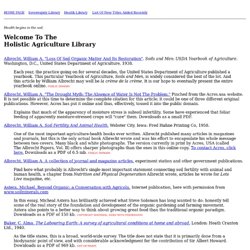
Welcome To The Holistic Agriculture Library Albrecht, William A. How to Build Irrigation-Free Raised Beds with Hugelkultur. Paul Wheaton/Video screen capture I've posted a video by Paul Wheaton on how to build "hugelkultur" raised beds before.

But with the tantalizing promise of vastly reducing, and possibly even eliminating, the need for irrigation, it seems like a topic worth revisiting. Developed by Austrian hill farmer Sepp Holzer, hugelkultur at its simplest is a process of piling up logs, brush and other carbon-dense biomass, and then building up raised bed gardens over the top of those piles using top soil and compost. The theory is that the biomass slowly decomposes over time, feeding the plants above with nutrients and also providing a sponge-like layer beneath the growing substrate—absorbing and rereleasing water to the plants as needed. As I mentioned in a previous article on hugelkultur, the process can be taken to what looks like relatively industrialized extremes—using diggers and earth movers to pile up biomass over huge distances.
Anyone have any insights? Permaculture Articles. This section of the online library contains an expanding offering of permaculture articles on concepts, techniques, practices and related skills.
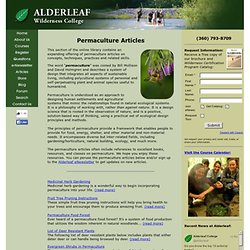
The word “permaculture” was coined by Bill Mollison and David Holmgren and describes a system of design that integrates all aspects of sustainable living, including polycultural systems of perennial and self-perpetuating plant and animal species useful to humankind. Permaculture is understood as an approach to designing human settlements and agricultural systems that mimic the relationships found in natural ecological systems. It is a philosophy of working with, rather than against nature. It is a design science that is rooted in the observation of nature, and is a positive, solution-based way of thinking, using a practical set of ecological design principles and methods. The principles of permaculture provide a framework that enables people to provide for food, energy, shelter, and other material and non-material needs.